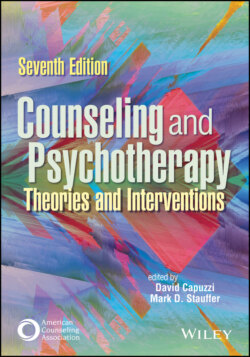Читать книгу Counseling and Psychotherapy - Группа авторов - Страница 159
REFERENCES
Оглавление1 American Psychiatric Association. (2013). Diagnostic and statistical manual of mental disorders (5th ed.). https://doi.org/10.1176/appi.books.9780890425596
2 American Psychological Association. (2017). Psychoanalysis vs. psychodynamic therapy.https://www.apa.org/monitor/2017/12/psychoanalysis-psychodynamic
3 Barry, V. (2014). Research on the relation of psychoanalysis and neuroscience: Clinical meaning and empirical science. Journal of the American Psychoanalytic Association, 62(6), 1087–1096. https://doi.org/10.1177/0003065114559944
4 Berlin, H. A. (2011). The neural basis of the dynamic unconscious. Neuropsycho-analysis, 13(1), 5–31. https://doi.org/10.1080/15294145.2011.10773654
5 Berne, E. (1961). Transactional analysis in psychotherapy. Grove Press.
6 Bond, M. (2006). Psychodynamic psychotherapy in the treatment of mood disorders. Current Opinion in Psychiatry, 19(1), 40–43. https://doi.org/10.1097/01.yco.0000191499.69281.17
7 Bowlby, J. (1969). Attachment and loss: Vol. 1. Attachment. Hogarth.
8 Bush, M., & Meehan, W. (2011). Should supportive measures and relational variables be considered a part of psychoanalytic technique? Some empirical considerations. International Journal of Psychoanalysis, 92(2), 377–399. https://doi.org/10.1111/j.1745-8315.2011.00403.x
9 Cabaniss, D. L., Cherry, S., Douglas, C. J., & Schwartz, A. (2011). Psychodynamic psychotherapy: A clinical manual. Wiley-Blackwell.
10 Corey, G. (2021). Theory and practice of counseling and psychotherapy (10th ed., enhanced). Cengage.
11 Diamond, D., & Meehan, K. B. (2013). Attachment and object relations in patients with narcissistic personality disorder: Implications for therapeutic process and outcome. Journal of Clinical Psychology, 69(11), 1148–1159. https://doi.org/10.1002/jclp.22042
12 Diena, S. (2014). Workshop on dream interpretation. Romanian Journal of Psychoanalysis, 7(1), 67–78.
13 Eremie, M. D., & Ubulom, W. J. (2016). Review of psychoanalytic approach to counselling. International Journal of Innovative Psychology & Social Development, 4(2), 22–25. https://seahipaj.org/journals-ci/june-2015/june-2016/IJIPSD/full/IJIPSD-J-4-2016.pdf
14 Freud, S. (1955). Beyond the pleasure principle. In J. Strachey (Ed. & Trans.), The standard edition of the complete psychological works of Sigmund Freud (1920–1922): Vol. XVIII. Beyond the pleasure principle, group psychology and other works (pp. 1–64). Hogarth Press. (Original work published 1920)
15 Fulmer, R. (2018). The evolution of the psychodynamic approach and system. International Journal of Psychological Studies, 10(3), 1–6. https://doi.org/10.5539/ijps.v10n3p1
16 Gay, P. (2006). Freud: A life for our time. Norton.
17 Georgescu, M. (2011). The duality between life and death instincts in Freud. Contemporary Readings in Law and Social Justice, 3(1), 134–139. https://doi.org/10.1016/j.ecolecon.2010.11.021
18 Haertl, K. (2008). Journaling as an assessment tool in mental health. In B. J. Hemphill-Pearson (Ed.), Assessments in occupational therapy mental health: An integrative approach (2nd ed., pp. 61–79). SLACK.
19 Haggerty, J. (2013). Psychodynamic therapy.http://psychcentral.com/lib/psycho-dynamic-therapy/000119
20 Horvath, A. O. (2005). The therapeutic relationship: Research and theory. Psychotherapy Research, 15(1), 3–7. https://doi.org/10.1080/10503300512331339143
21 Johnson, A. L. (2016). Psychoanalytic theory. In D. Capuzzi & D. R. Gross (Eds.), Counseling and psychotherapy: Theories and interventions (6th ed., pp. 73–96). American Counseling Association.
22 Katz-Bearnot, S. (2009). Combined psychotherapies: Searching for an order of operations in a disordered world. Journal of the American Academy of Psychoanalysis and Dynamic Psychiatry, 37(2), 299–313. https://doi.org/10.1521/jaap.2009.37.2.299
23 Lemma, A., Target, M., & Fonagy, P. (2011). Brief dynamic interpersonal therapy: A clinician’s guide. Oxford University Press.
24 Levenson, L. N. (2007). Paul Gray’s innovations in psychoanalytic technique. Psychoanalytic Quarterly, 76(1), 257–273. https://doi.org/10.1002/j.2167-4086.2007.tb00254.x
25 Lijtmaer, R. (2006). Black, White, Hispanic and both: Issues in bi-racial identity and its effects in the transference-countertransference. In R. Moodley & S. Palmer (Eds.), Race, culture and psychotherapy: Critical perspectives in multicultural practice (pp. 130–138). Brunner-Routledge.
26 Lingiardi, V., McWilliams, N., Bornstein, R. F., Gazzillo, F., & Gordon, R. M. (2015). The Psychodynamic Diagnostic Manual Version 2 (PDM-2): Assessing patients for improved clinical practice and research. Psychoanalytic Psychology, 32(1), 94–115. https://doi.org/10.1037/a0038546
27 Lothane, Z. (2009). Dramatology in life, disorder, and psychoanalytic therapy: A further contribution to interpersonal psychoanalysis. International Forum of Psychoanalysis, 18(3), 135–148. https://doi.org/10.1080/08037060903116154
28 Luyten, P., Mayes, L. C., Fonagy, P., Target, M., & Blatt, S. J. (2015). Handbook of psychodynamic approaches to psychopathology. Guilford Press.
29 Markowitz, J. C., Lipsitz, J., & Milrod, B. L. (2014). Critical review of outcome research on interpersonal psychotherapy for anxiety disorders. Depression & Anxiety, 31(4), 316–325. https://doi.org/10.1002/da.22238
30 Markowitz, J. C., & Weissman, M. M. (2004). Interpersonal psychotherapy: Principles and applications. World Psychiatry, 3(3), 136–139.
31 Petrocelli, J. V., Glaser, B. A., Calhoun, G. B., & Campbell, L. F. (2001). Early maladaptive schemas of personality disorder subtypes. Journal of Personality Disorders, 15(6), 546–559. https://doi.org/10.1521/pedi.15.6.546.19189
32 Pigman, G. W., III. (2014). Freud and his manuscripts: A critical edition of beyond the pleasure principle. American Imago, 71(1), 85–88. https://doi.org/10.1353/aim.2014.0000
33 Poulsen, S., Lunn, S., Daniel, S. I. F., Folke, S., Mathiesen, B. B., Katznelson, H., & Fairburn, C. G. (2014). A randomized controlled trial of psychoanalytic psychotherapy or cognitive-behavioral therapy for bulimia nervosa. American Journal of Psychiatry, 171(1), 109–116. https://doi.org/10.1176/appi.ajp.2013.12121511
34 Riker, J. H. (2013). The philosophical importance of Kohut’s notion of the self. International Journal of Psychoanalytic Self Psychology, 8(4), 495–504. https://doi.org/10.1080/15551024.2013.825952
35 Rowe, C. (2013). Extending Kohut’s concept of self-object: The undifferentiated self-object. Clinical Social Work Journal, 41(1), 26–33. https://doi.org/10.1007/s10615-011-0361-2
36 Rutan, J. S., Stone, W. N., & Shay, J. J. (2014). Psychodynamic group psychotherapy. Guilford.
37 Scarfone, D. (2018). Free association, surprise, trauma, and transference. Psychoanalytic Inquiry, 38(6), 468–477. https://doi.org/10.1080/07351690.2018.1480232
38 Seligman, L., & Reichenberg, L. W. (2014). Selecting effective treatments: A comprehensive systematic guide to treatment mental disorders. Wiley.
39 Shedler, J. (2010). The efficacy of psychodynamic psychotherapy. American Psychologist, 65(2), 98–109. https://doi.org/10.1037/a0018378
40 Sonnenberg, S. M. (2011). Psychoanalysis and the United States research university: Current trends. International Journal of Psychoanalysis, 92(3), 641–659. https://doi.org/10.1111/j.1745-8315.2011.00450.x
41 Swartz, S. (2014). Words, interpretation and setting: Changing forms of the talking cure. Psycho-Analytic Psychotherapy in South Africa, 22(1), 1–25.
42 Thomas, B. (2008). Seeing and being seen: Courage and the therapist in cross-racial treatment. Psychoanalytic Social Work, 15(1), 60–68. https://doi.org/10.1080/15228870802111807
43 Wedding, D., & Corsini, R. J. (2014). Current psychotherapies (10th ed). Brooks/Cole.
44 Weiss, H. (2014). Projective identification and working through of the countertransference: A multiphase model. International Journal of Psychoanalysis, 95(4), 739–756. https://doi.org/10.1111/1745-8315.12218
45 Zepf, S. (2010). Libido and psychic energy—Freud’s concepts reconsidered. International Forum of Psychoanalysis, 19(1), 3–14. https://doi.org/10.1080/08037060802450753
